The online shopping craze, which is increasing day by day due to the changing world and the pandemic, has led to serious competition among users selling from online marketplaces. The number of active sellers on Amazon, one of the world's largest marketplaces, reached approximately 2.4 million in 2021. This means that competition among sellers is quite high.
Just as search engines like Google have a ranking algorithm, giant e-commerce sites like Amazon also have an algorithm that works in the background. Amazon calls the ranking algorithm within the site A9, and with the latest improvements, the A10 algorithm. This algorithm continues to be improved day by day to offer the best product to users. Therefore, if you want to increase your Amazon sales, you should develop your store and optimize your product pages in accordance with the Amazon algorithm. Here, we will call the optimization processes you need to perform here Amazon SEO.
What is Amazon SEO?
Amazon SEO is the process of improving your Amazon store and products in accordance with the Amazon ranking algorithm. As with SEO, there are known ranking factors in Amazon SEO, but there are also many unknown ranking factors. Although there are some objections on the subject, it is known that the Amazon ranking algorithm works based on about 200 factors.
How Does Amazon Search Algorithm Work?
The Amazon search algorithm, known as A9, or A10 in its most recent form, is based on a number of factors but is fundamentally focused on relevance and efficiency. As with other search engines, the Amazon A10 algorithm compares the relevance of the page content you create and the relevance of the search and acts in a way to offer the most accurate product to users. In the efficiency factor, conversion rates and different performance evaluations come into play.
Amazon SEO: What are the Ranking Factors?
As mentioned above, it is estimated that Amazon ranks products by evaluating around 200 different ranking factors. Some of these factors are known, while others are kept secret. The main known ranking factors are as follows.
- Product Title
- Product Description
- Price
- Product Images
- Store Name
- Bullet Points
- Search Terms
- Category Selection
- Conversion Rate
- Reviews
1 - Product Title
One of the first things that customers will pay attention to on product listing pages is the product title. Therefore, when choosing your product title, you should choose a title that is as simple, and clear and conveys the product in the best way possible. The Amazon Seller Central guide states that product titles that are not created in accordance with the requirements may not rank in search results.
The main things to consider when creating a product title:
- Although Amazon recommends setting a maximum character limit of 80 for your title, best practices show that product titles of 100 - 150 characters rank better.
- Important details such as color and quantity should be included in the product title.
- Except for conjunctions, product names should be determined with capitalized initials and the rest in lowercase.
- Numbers should be indicated by numbers, not by writing (for example, using 7 instead of seven).
- Try to include your targeted keywords in the product title as much as possible.
- Use "-" or "|" symbols between details to increase the readability of the title.
The things to avoid when creating a product title are mainly as follows.
- Capital letters should not be used in all headings.
- Non-linguistic ASCII characters such as Æ, ©, or ® should not be used.
- Subjective comments such as Best Sellers, Best Product, Free Shipping, etc. should not be used.
- There should be no seller name in the product title.
- The title should not contain more information than necessary.
- Keyword stuffing should be avoided in keyword usage.
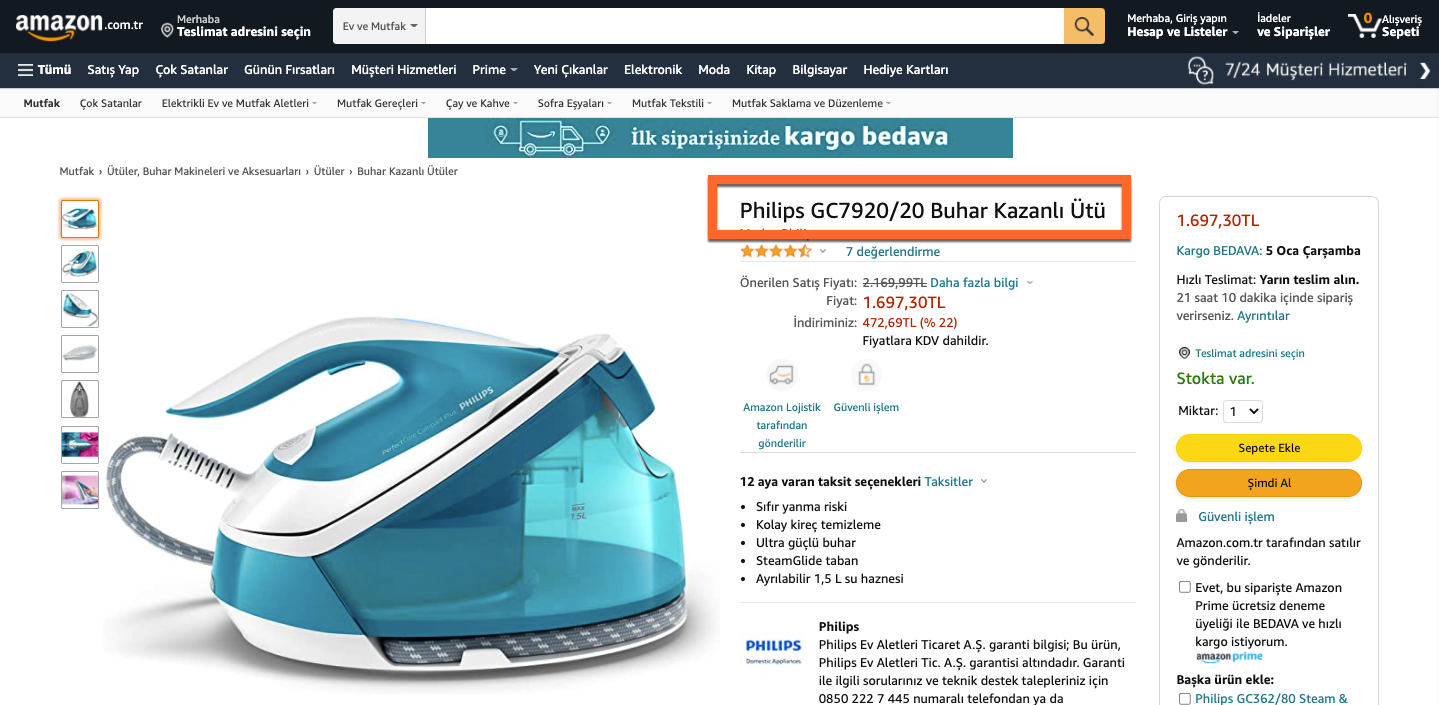
Amazon may have different title rules according to categories. Therefore, you need to optimize your product title in accordance with the category in which your products are listed.
2 - Product Description
The product description is one of the most important ranking factors. Optimized product descriptions will both allow you to rank higher in search engines and increase your conversion rates by convincing the user to purchase.
The things to consider when creating a product description are as follows.
- Your descriptions should be short and clear.
- Only real information should be included in the descriptions.
- Target keywords should be used in the product description without keyword stuffing.
- Competing brands should never be used in the description. Otherwise, your product may be removed from search results.
3 - Price
Product prices play an important role in the user's purchasing process. If you want to sell on a highly competitive marketplace like Amazon, you can compare the price of the products you sell with other stores selling similar products. If your product price is much higher than the average, your conversion rate will probably be lower than other stores you compete with. In addition, selling similar products at a higher price than your competitors will result in lower rankings than yours competitors according to the Amazon algorithm.
In order to increase your sales amount, you should definitely examine the stores that sell similar products and set your product prices according to competitor analysis.
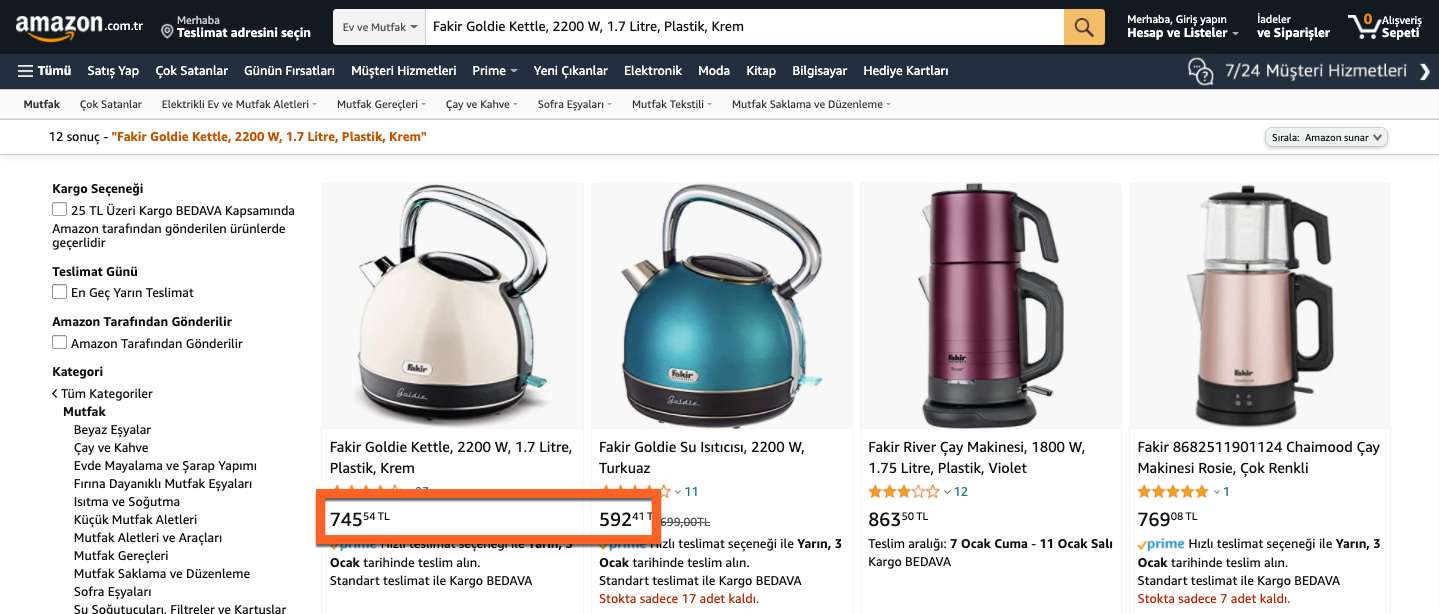
4 - Product Images
Product images, like the product name, are the first elements that users pay attention to when making a purchase decision. Quality and attractive product images have a higher conversion rate than poor-quality product images.
A minimum of one image should be added for product detail pages. The Amazon Seller Central guide recommends adding 6 images and 1 video content to your product pages.
Images should be clear, informative, and eye-catching. The first image you add is the product image that will be ranked on search and category pages. Therefore, your first image should be created with only the product for sale on a white background. Other images can include images of the product from different angles or from the moment of use.
Other details to consider when adding product images:
- Images should be real photo that accurately represents the product to be sold. Graphics, drawings, models, etc. are not allowed.
- Images should consist of professional photographs with high image quality. Blurred, pixelated images will negatively affect sales.
- The image must match the product title.
- White background must be used in the image (RGB 255, 255, 255)
- The product must cover at least 85% of the image.
- Images must be in JPEG, TIFF, PNG or GIF format.
- Images should not contain inappropriate elements such as nudity etc.
5 - Store Name
The keywords you use in the store name are effective in Amazon search results. Creating a store name related to the products you sell can create a ranking advantage for your store.
For example, the example below shows the products that users who search for American Flag Ties for Men come across. We see that the Man of Men store in the second row targets the search query with men in the store name. When men are removed from the search results, the position of the Man of Men store changes.
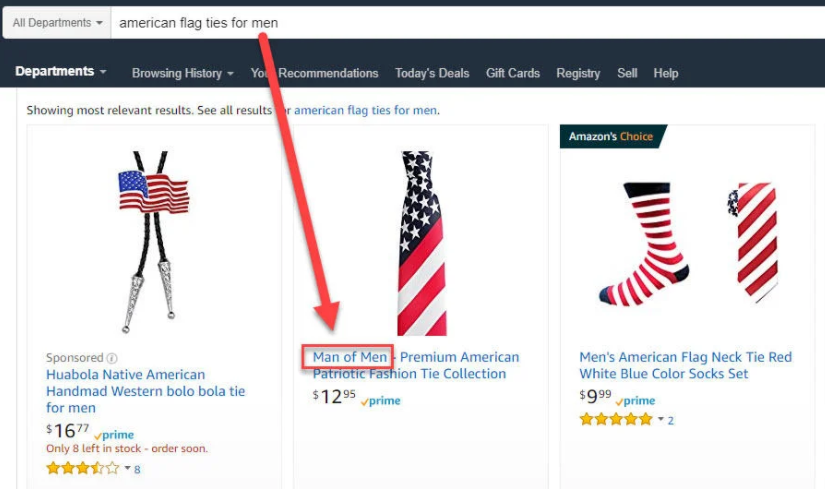
6 - Bullet Points
Bullet points are descriptive texts added to product detail pages in bullet points. Bullet points, which are the first place users look for information about product features, should be written in a simple language that the user can understand, without keyword stuffing. Complicated and keyword-focused bullet points will negatively affect the user's purchase decision and cause your conversion rate to decrease.
Seller Central guidelines state that a maximum of 5 bullet points should be written for each product and the description should be under 1000 characters.
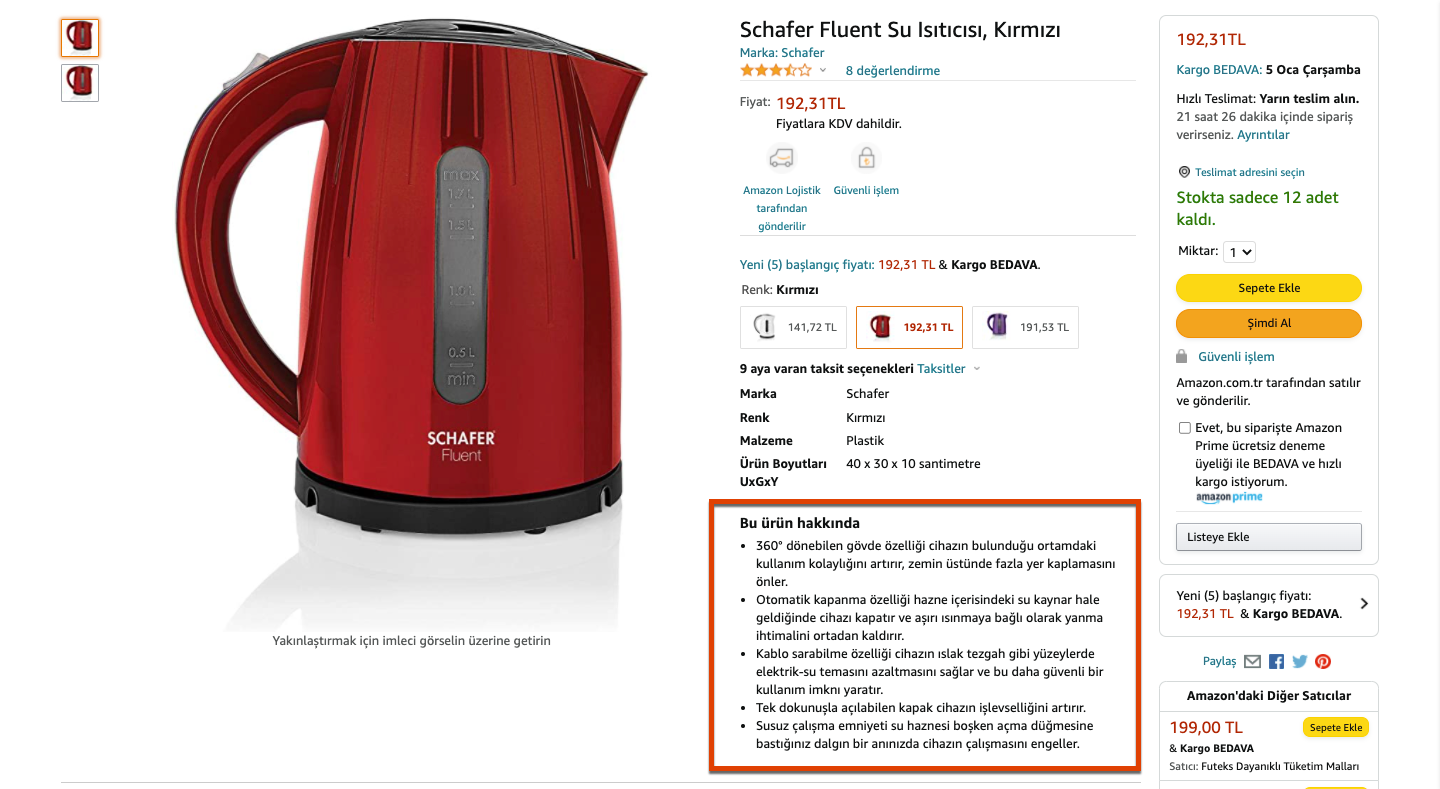
The use of keywords in bullet points has an impact on your ranking positions on Amazon, just like SEO, but well-written articles will naturally include keywords. Therefore, you should take care to provide useful information to users in bullet points by avoiding excessive use of keywords.
7 - Search Terms (Backend Keywords)
Search terms are hidden keywords that the Amazon algorithm uses to better understand what the product is about. As the term "hidden" suggests, these keywords are words that are invisible to the user but visible to the bots. According to Seller Central, the following factors should be considered when determining search terms:
- Do not exceed the 250-byte length limit.
- Include alternative, synonymous words that users can use when searching for products.
- Include different spelling variations.
- Include abbreviations and alternative uses.
- You can write all in lowercase.
- You do not need punctuation marks such as ";", ":", "-".
- Put spaces between words.
- Do not repeat words in the search terms field.
- You do not need to include words like "a", "for", "with", "and", etc.
- Use singular or plural nouns, not both.
For the search term, Amazon gives users 50 bytes of space on 5 different lines. Below you can see an example of search terms for the bamboo cutting board product.

8 - Category Selection
Choosing the right category is critical for conversion. Products added to the wrong category will not rank and your sales will be negatively affected. Therefore, you should make sure that the products you sell are in the right category. For this, you can examine the categories under which competitors sell the same or similar products as you list their products and you can easily discover the right category.
Also, according to Amazon policies, some products offered for sale on Amazon must meet certain certification standards. In order to realize the sales of these product groups, you need to meet the necessary conditions. For example, in order to sell organic food on Amazon, you must submit an approval application to Amazon. After your product is examined, if it meets the necessary conditions, it is offered for sale. In addition, many products and product groups such as batteries and chargers, baby car seats, baby sleeping mats, squeeze-and-drop toys, slime, and magnetic sand are subject to additional restrictions. You can get detailed information about all categories and products that require approval from Seller Central.
9 - Conversion Rate
Conversion rate is one of Amazon's performance-based ranking factors. The more the product detail page is clicked on, the more sales are made; Amazon's algorithm assumes that users are interested in this product and will highlight the relevant product and position it at the top. Therefore, instead of optimizing your product pages in accordance with the Amazon algorithm, you can strengthen your profile to optimize your conversion rate.
For example, if you sell a product at a higher price than your competitors, instead of stuffing keywords in your product descriptions to make your product stand out, you can bring the product price to normal levels with discounts, etc. to highlight your product and increase the conversion rate by making more sales.
In addition, some studies have shown that no optimization you make is as important as sales.
cannot make you stand out. If you haven't made any improvements to your profile but the algorithm ranks you higher, you can assume that your conversion rate is higher than your competitors.
To check the conversion rate, you can track the Unit Session Percentage value under Business Report in Seller Central, which refers to the purchase per page view metric. If you think this value is lower than you expected, it would be useful to optimize your page by considering other ranking factors.
10 - (Reviews)
Reviews are among the most important performance-based ranking factors after conversion rate. E-commerce users trust other users rather than sellers before making a purchase decision. Therefore, having a good review history can significantly increase sales rates, while a review history with bad reviews can seriously negatively affect sales rates. Therefore, you should take care to get high reviews from users as much as possible.
The Amazon ranking algorithm works in a way to position products with high reviews at the top. Tests show that products with 4 stars and above are ranked higher in Amazon search results than products with less than 4 stars.

Tools You Can Use for Amazon SEO:
There are many tools you can use to strengthen Amazon's sales performance. The main Amazon SEO tools are as follows.
1 - Helium 10
One of the tools you can use to increase Amazon sales is Helium 10, which includes many different tools. Helium 10 provides one-stop tracking and management of all the tools that users who sell on Amazon may need for product research, keyword research, listing optimization, operation process, and marketing. It also includes a keyword analysis tool and a keyword tracking tool that you can use for Amazon SEO. Depending on the needs and size of your business, you can benefit from different packages of Helium 10 and support your Amazon sales.
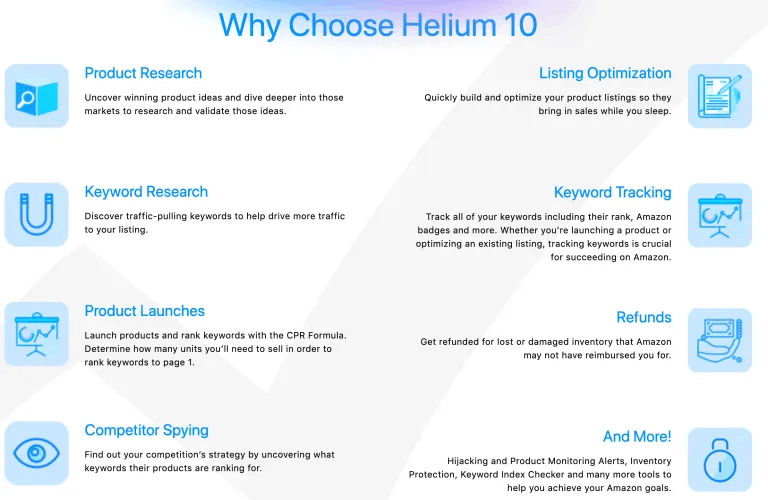
2 - Seller App
Another tool to support Amazon sales is Seller App. With Seller App, you can perform keyword analysis and track positions based on the queries you aim to sell. Seller App also provides users with useful data for PPC campaign management.
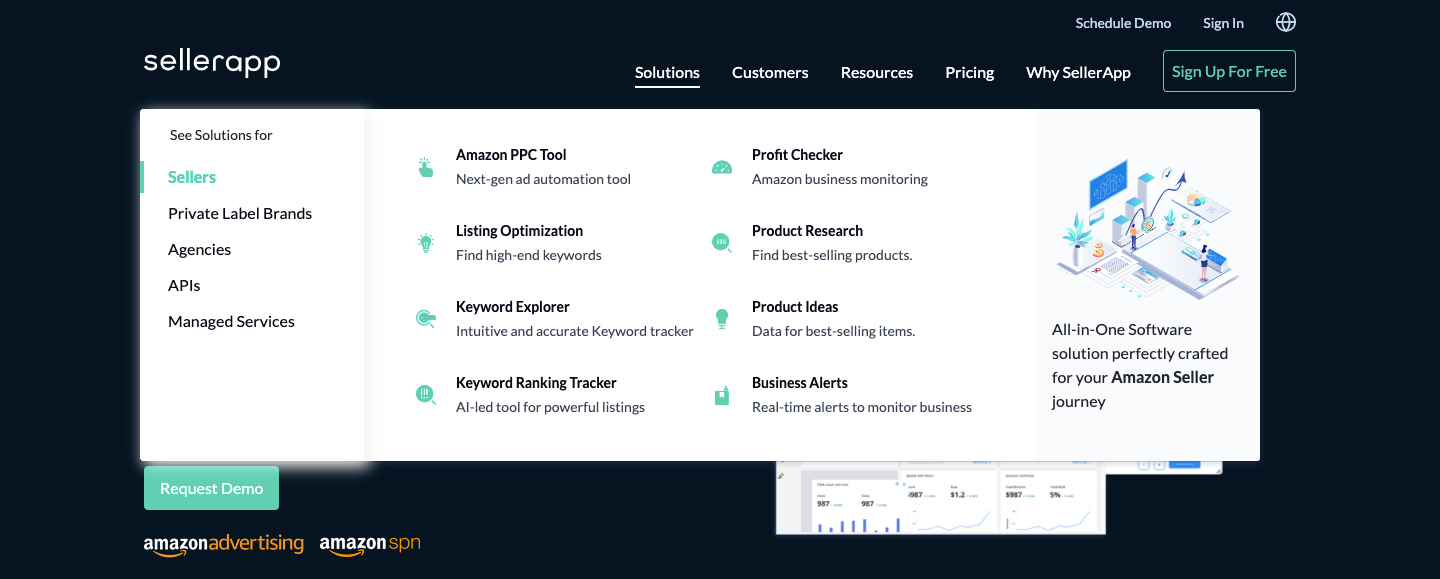
3 - Seller Labs
Seller Labs is a comprehensive tool designed to support your Amazon sales. With Seller Labs, you can manage your Amazon store on a single platform and closely monitor performance changes. The tool also includes a keyword analysis tool with detailed information such as keyword volume and estimated sales. By performing keyword analysis with Seller Labs, you can measure your performance on the queries you target sales and support your Amazon sales.
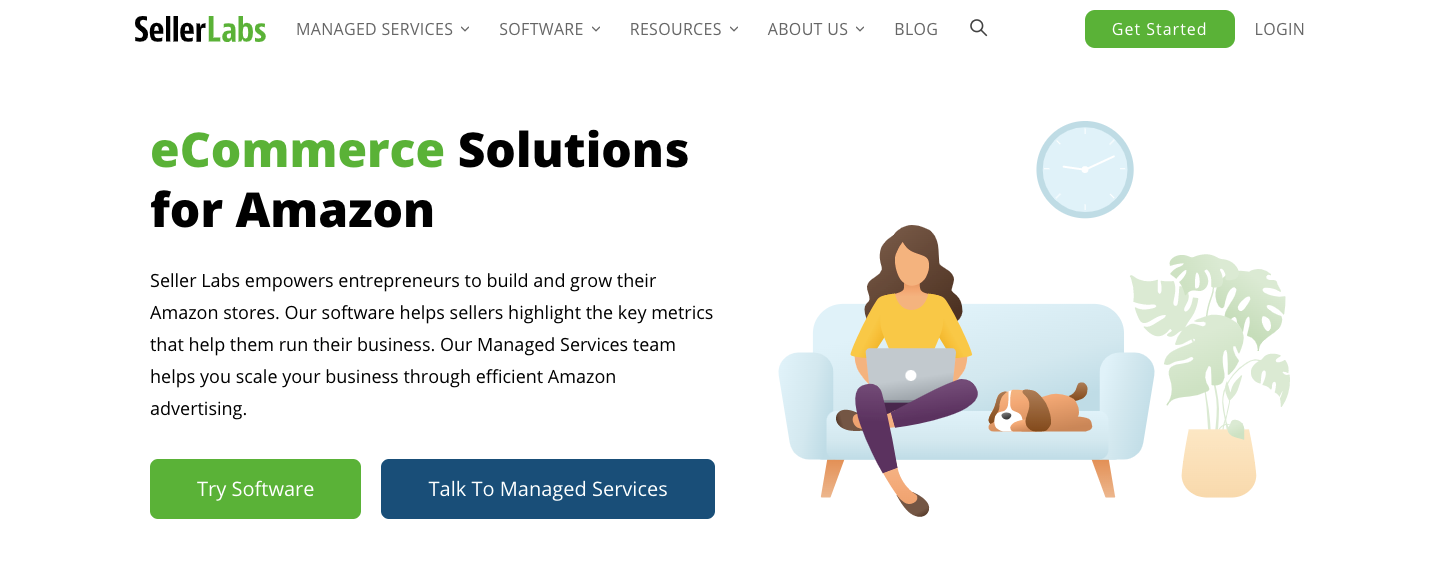
4 - Jungle Scout
Jungle Scout, which emerged with the aim of enabling users to do product research, has become a highly advanced tool that includes many helpful tools. With Jungle Scout, you can easily manage inventory management as well as product page optimization and manage your Amazon store on a single platform.
Among the most popular tools of Jungle Scout are Supplier Database and Opportunity Finder. With Supplier Database, you can easily find the right supplier for your product and get detailed information about general supplier evaluations. Opportunity Finder is one of the most useful tools for product research. With Opportunity Finder, you can reach keywords with high opportunity scores, stand out from your competitors and support your sales with new opportunities.
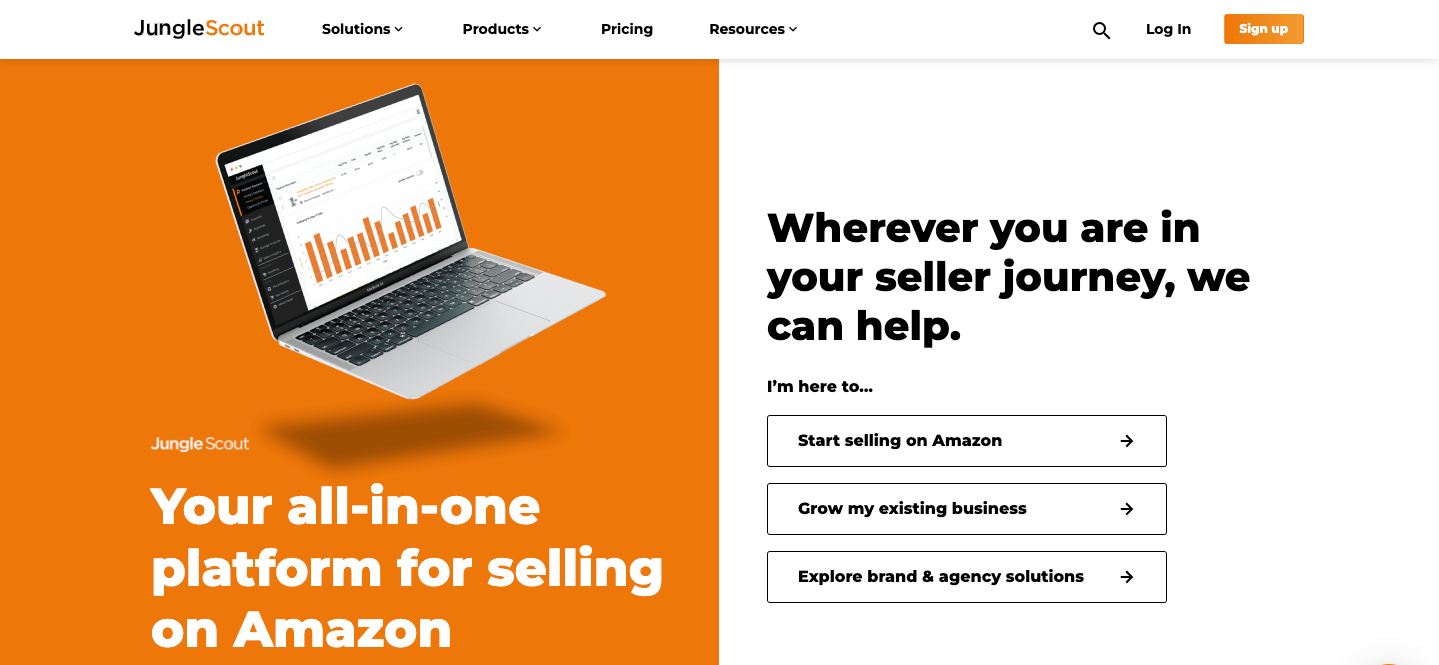
5 - AMZScout
With AMZScout, one of the popular Amazon tools, you can conduct product research to identify profitable products and improve the listing performance of your products.
AMZScout has 2 different packages PRO Extension and Amazon Seller's Bundle. You can support your sales with AMZScout, which is especially suitable for beginner and low-budget Amazon sellers, and you can get detailed information about the tool with the trial version.

Conclusion:
In summary, we can say that the Amazon ranking algorithm does not work much differently from the Google algorithm, the basic principle is to give the user the most relevant result in both. Therefore, as an Amazon seller, you should include important information that users can search for on your product pages, perform keyword analysis and perform optimizations to increase relevance. You can also positively affect Amazon conversion rates by providing requirements such as communicating well with the customer and providing quality service. You can also support your Amazon sales and get ahead of your competitors by using tools that provide useful services such as Amazon SEO and inventory management.
Sources:
https://www.businessofapps.com/data/amazon-statistics/
https://www.sellerapp.com/blog/amazon-product-listing-guide/
https://sellercentral.amazon.com/gp/help/external/GYTR6SYGFA5E3EQC
https://sellercentral.amazon.com/gp/help/external/help-page.html?itemID=51
https://sellerinteractive.com/blog/amazon-seo-guide/
https://www.wordstream.com/blog/ws/2018/05/17/amazon-seo
https://www.brandingturkiye.com/dunyanin-en-degerli-100-markasi-2021/
https://influencermarketinghub.com/amazon-seo-tools-services/

















